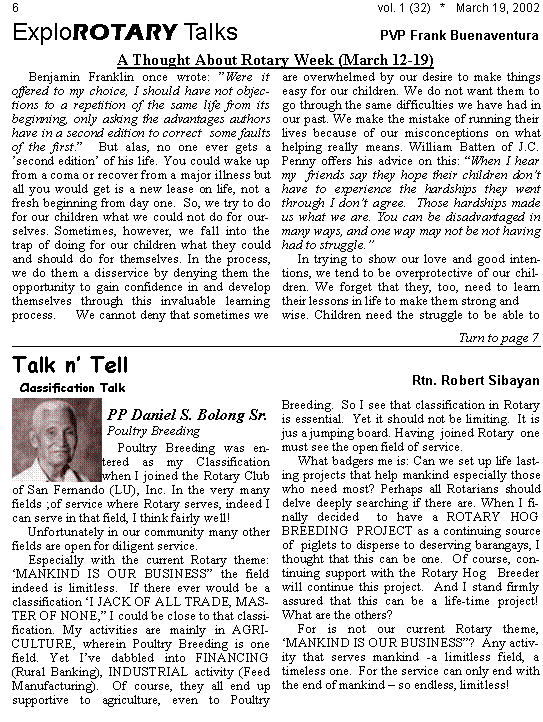
|
5 |
|
Heart ‘n Pillars |
|
PAST PRESIDENT’S CORNER - Asst. Ed Dindo Astom |
|
Rotary Challenges BY PP ROBERT “Bob” F. KAISER |
|
Wow! Our editor must be running out of
topics. I am instructed to write about challenges in Rotary. That is a
challenge in itself. What challenges
are we talking about? Personal, Club, District, or International. Let us confine this then to the personal
level. It would seem to me that the challenges come in phases; young, midlife and senior;
that is in terms of Rotary membership.
What I say below would certainly not apply to other members in general
but are rather my personal recollections and observations. As a new member it was certainly a
challenge to feel accepted. Our club has never been able to completely get
away from the cliquish seating arrangements where every week you would see
the same group sitting together. This can be quite disconcerting to a new
member. PP Arsing tried to provide a
remedy several years ago with the rotating seats but it did not prosper. This
is a challenge to our club to get the new members welcome and involved. Also, I see a number of new members today who attend our meetings but are rarely included in the proceedings. This is a challenge to both the club and the member; the young Rotarian |
|
PP ROBERT F. KAISER President RCSFU Rotary Year 1983-1984 Theme: “Share Rotary, Serve People” |

|
March 19, 2002
* vol. 1 (32) |
|
must be made to be not
only an important member but a future leader. There seems to be two classes of
members, those that are super members and those that are not fully involved
and integreated. A challenge facing our club is to not just have members but
to get them really involved. This is seen in the fact that we are now having
problems getting new a new president elect. This has not happened before. The current challenges of senior
membership are also serious. Our club
has the excellent policy of keeping the senior members out of the current
stream of management. But, at the time of life were some of the senior
members in their own fields of classification are more inclined to giving
instructions rather than being foot soldiers, then how does the more senior
member fit into the picture. Sure, many of the “seniors” attend the regular
meetings, but how many go on the club medical missions, visit the remote
sites, attend district or mid year conferences? How do we keep Rotary membership more of a
challenge rather than an obligation? As far as I know neither our club, the
district or RI has addressed the issue of Rotary “burn out”. My own personnel feeling is one of
experiencing this burn out. After 26 years in Rotary, how to be meaningful is
the question. Fifteen years ago I was happy to run out to distribute
medicines every week to the leprosy patients. But I probably wouldn’t do the
same thing now. Perhaps a number of our senior members who were once very
active, but now attend only the anniversaries and the special events, feel
the same way. We have a number of truly excellent past
presidents, but they soundly refuse to go further |


|
Turn to page 7 |